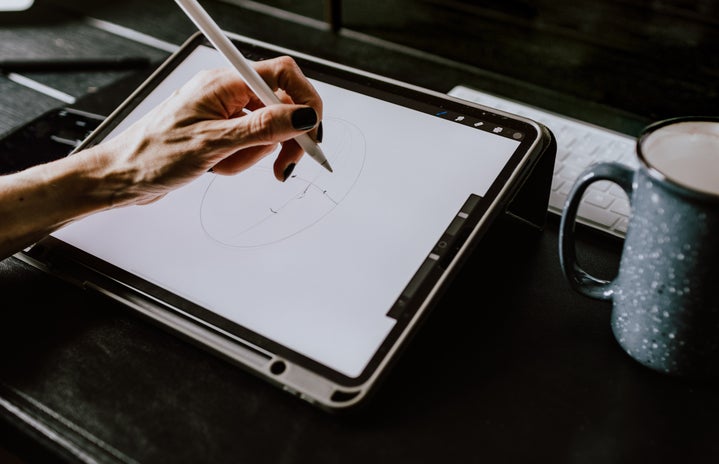Helô D’Angelo wakes up close to 11am, eats breakfast and goes to her daily mandatory walk in a plaza near her house. There, she puts together the useful and the nice: tones a little in the sun while she organizes the rest of the day in her head. She goes prepared, because she knows there will be ideas along the way. With paper and pen in hands, traces come alive right on the spot. It is also the moment where she makes up some sketches for the Mamilos podcast’s cover. After that, she goes back home, and it’s there where she starts to really get to work. Then, eats lunch and continues her duties until dinner time, which is when she stops and focuses on lighter things. Watches a movie or a tv show and rests for another round of ideas the next morning.
So that no idea slips out of sight, not even while sleeping, Gilmar Barbosa has already slept with a clipboard in tow at the time he was doing daily drawing strips. Nowadays, because of independent work, he doesn’t submit for more pressure to create something every day. His everyday life consists in keeping up with the news to have ideas, make a political drawing and post it on social media. With a project that wants to conclude still in this government, Gilmar makes many political charges that are compiled, at every end of the year, in a book. Two were already made, still there are two more to go so that the collection is completed.

Like Gilmar, Daniel Lafayatte established his own work hour, because he doesn’t have a steady job and ideas, as you know, have no stable time to show up. Sometimes, they come up when he is really focused or simply out of nowhere, there isn’t a formula, but Daniel always looks at the newspaper and Twitter, just to exercise, as he said, his critical look by informing himself. To maintain a lively imagination, Daniel is always connected with other types of art, from what he appreciates to what is unknown to him, everything is influential. Helô also believes that consuming different things, such as movies, animations, comic books, and even by talking with other artists, feeds up creativity, but she recognizes that resting is fundamentally necessary. “I had many problems at the end of last year, precisely because I was trying to work too much. I was anxious and couldn’t do anything besides working, and, little by little, this was eating my imagination. It made me even more nervous, and I tried to work even more. I thought I was being lazy, it made me feel guilty and couldn’t realize that it was drowning my creativity”, she remembers. Nowadays, what she’s doing -and what works for her- is to follow a routine, delimitating a moment to work and another to rest.
Helô tries to draw every day, except for the weekend. Besides being the coverer of the Mamilo podcast, she’s also a cartoonist in Brasil de Fato and works as a freelancer in the area. “Usually, I pick up a work that I need to develop and chat a little with the client about what he wants and then, someday, I sit and make a thousand outlines. After that, I select some of them and send to the client”, she states. She also has some personal projects. One of them is developing her own book entitled “Isolamento”, a collection of comic strips serialized after her neighbors. Previously, since March 2020, the comic strips were being posted as web comics. To create them, Helô declares that she prefers to put her ideas on paper right when they appear whether to wait to draw when she has a lot in her mind: “This thing about taking too much time planning, thinking about a thousand of things, isn’t my thing. I have to start doing it, or else the idea starts to die.”
She also posts her drawings on social media. “I’m always publishing what I make, always interacting with the public that follows me. One thing that works well for me is creating serialized drawings, so, every week there’s an episode.” At the beginning, Helô did a lot of quick drawings with subjects that were on the media. But with time, she understood that, sometimes, it become shallow and started reproducing prejudices, “I didn’t think too much. I was doing the first thing that came through my mind too quickly, without reflecting about it.” Nowadays, she doesn’t do it anymore, but Helô knows that, to stay on the heat of the news, to get subjects that are at the top of the moment is a good option. “There are people who do it and like it, and this really works, because you will have a good reach on that work that you posted,” she explains.
Gilmar notices the action of time upon his workflow, above all, on the development of his critical sense: “I suffer very much with work, because we’re getting older, and getting more critical. Today, it is much more required, especially when you have a public that has eyes on what you’re doing”. Not only your own public, but other people also consume your creation, and there is a chance they go viral on the internet, which ends up being a showcase for the work of illustrators and cartoonists. Thanks to social media, the cartoons also became more popular by being dynamic and quickly spread. “By the reach it has, it is an amazing thing. Sometimes I receive 60-70 thousand likes. It is an absurd thing. Right now, the networks have been essential for me”, Lafayatte reveals.
To conquer a specific public, Helô, besides always updating her network, does lives and videos showing her artistic process, because people like to ask and interact. Also, she registered in Apoia-se, which is almost like a Catarse – a way of collective financing. The only difference is that it is monthly. “People basically contribute so that I can have a salary and then I give out some exclusive things to them every month, a newsletter and the access to a secret page on Instagram”, she specifies. Gilmar sums up: “So, it’s the creation of a public and the affinity with the language that you defend and that you draw, that feeds and, in a way, gets you.” He also tries to monetize by making books and selling what he already produced along the years, for both readers and for editors, especially textbooks, which buys the copyright usage for images, helping even more is his monthly salary due to scarcity of jobs..

The biggest challenge of the profession, according to Lafayatte, is the lack of interest in paying the class in a fair way; usually it isn’t a very well-paid class, besides media and traditional vehicles who aren’t able to serve right the number of people who work as cartoonists, bigger clients, sometimes, look for beginners, because they know they will charge less. Helô agrees that this is a floating market, for the fact that many people want to enter and charge less on work that should not be charged that way, it ends up being too competitive and is hard to create a consciousness on the artistic class. Gilmar cites something that gets him out of his head: “The person saying that he will pay for your job by only putting the credit on the drawing – as if we needed that. For people who are beginning on this, it’s almost okay. So, the challenge is being steady and firm as a professional in this area, being respected and paid for it.”
Another difficulty found by Gilmar is the Brazilian prejudice with art, people thinking that is just a hobby. Helô goes deeper and points out that there is another type of prejudice: people thinking about comic books as a ludic thing and associate them, automatically, with the children’s audience, “but what we need to make people understand is that comic books are a media just like any other. Like text, video, podcast.” She reveals that even the editors and the gatekeepers behind the vehicles think that it is childish and only accept to do a comic article when it’s about comic books or about art, as if it was a curiosity: “When we will propose a comic article, it is very hard, people still think that there’s only the need to explain what is a comic book. But no, it shouldn’t, who looks at it will already know what it is.”
Knowing that drawings, usually, are discriminated in relation to writing, Helô realized that using them to make articles with the most various topics is a way to change the opinion of people. “I think that to break this prejudice it is only by doing more of that, just as me and my friends – Alexandre de Maio, Gabriela Güllich, Carol Ito, Robson Vilalba, Pablito Aguiar – in which we agree to use any vehicle to talk about comics so that, in some time, we have so many examples that there isn’t a way to have this type of prejudice.” Helô believes that journalism can benefit a lot with comic, since it is a dynamic media, easy to read, more democratic and that can be used in various ways. “One of them is to simplify content that is hard to explain, add info graphics. The other one is to protect the identity of the source, instead of giving a fake name, just as we do in text, or put a duck voice, just as we do in video, you can show the face, asking them how they would like to be represented and draw a face that aren’t theirs. Besides that, it’s so much fun to read comic books and I think that it’s a great solution for that ‘laziness’ that people usually have while reading longer texts.”
Gilmar agreed that we are in a moment of lazy reading, what gives the order is the quick click, the instant information. In this way, he believes that charges have been showing as a very important tool in this political moment that Brazil is living, by the dynamic in which are broadcasted in social media. “They annoy, because they communicate quickly, in an ironic and critical way. So, they have this role and this power to bother, to tear down, dismantle a structure which is built by a governor. I think that charges, the sinical humoristic drawings, have a fundamental role, and that we, thus, have an important role at this moment,” he concludes.
———————————————————————
The article above was edited by Laura Enchioglo.
Liked this type of content? Check Her Campus Casper Libero home page for more!


